Bullhorn Alternatives
A detailed comparison of 10 Bullhorn alternatives. We analyze features and pricing to help you select the best recruitment software for your firm.

Bullhorn is a popular choice in the staffing industry for good reason. It combines applicant tracking with CRM features, helping firms manage the entire recruitment lifecycle. For many, this specialized focus is exactly what they need.
But no tool is perfect. Some users say the interface can be complex and report occasional slow performance. We've analyzed top alternatives against Bullhorn, using G2 reviews, to help you create a shortlist for a deeper review. Let's get started.
For Sales Automation, Consider 11x
If your goals include sales task automation, consider 11x. The platform provides digital workers for sales development. This approach helps teams expand sales outreach without a larger headcount. You can explore how it might fit your strategy.
11x is a GTM platform where AI agents manage the sales process. An agent named Alice finds prospects, conducts outreach on email and LinkedIn, and maintains the CRM. A second agent, Julian, qualifies inbound leads and books meetings. This consolidates data enrichment, outreach, and email warmup tools into one platform.
Bullhorn Alternatives
The following section reviews top alternatives to Bullhorn, comparing them on pricing, core features, and specific pros and cons. This detailed breakdown provides the information needed to evaluate each option against your specific requirements.
1) Lever
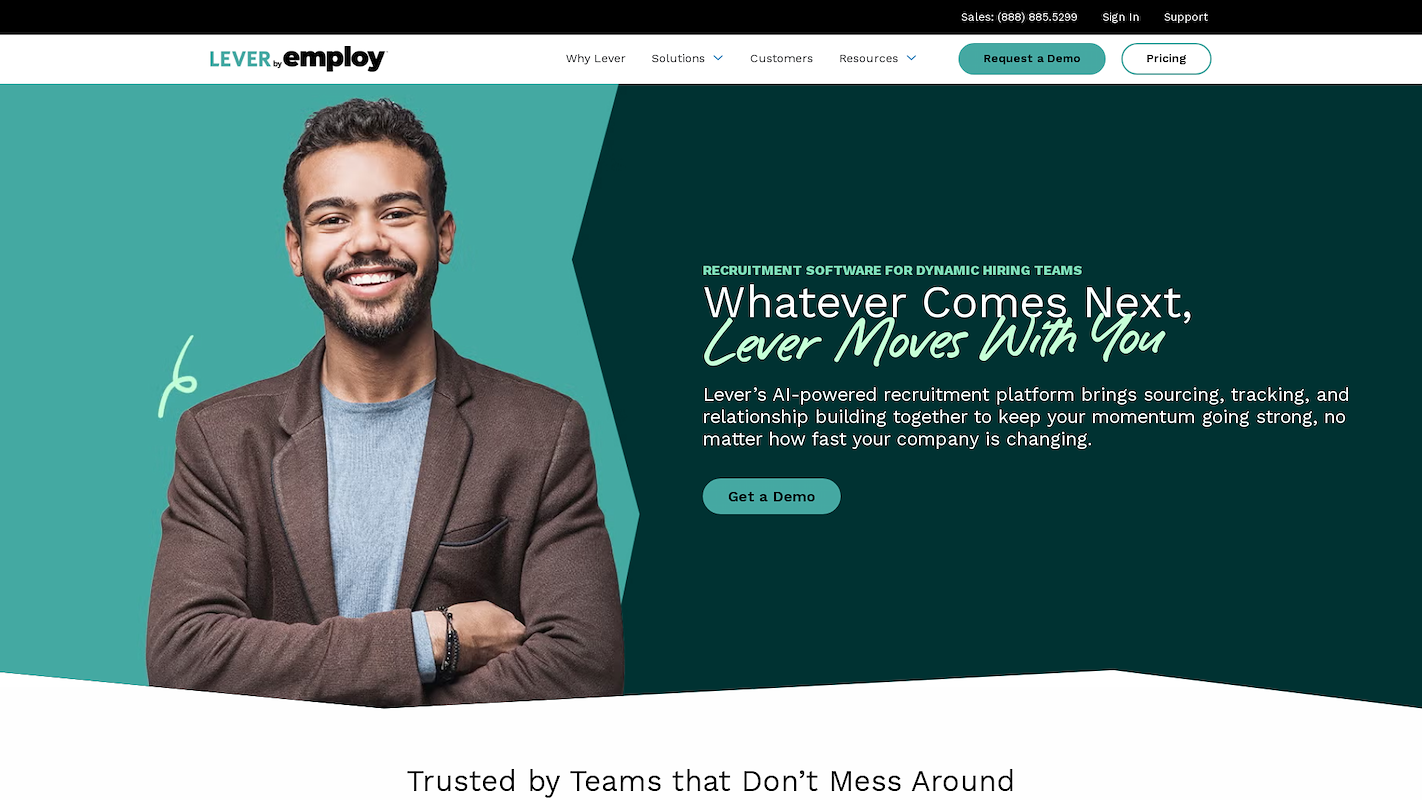
Lever is a recruitment platform that unifies applicant tracking, candidate sourcing, and relationship management. It is designed for companies that experience constant growth or change. The system supports the full recruitment cycle, from requisition to a new hire's start.
It provides analytics to improve pipeline management and reports. The platform offers different product options for companies of any size, from startups to enterprises, to match their scale.
Lever's Main Features
- Offers an integrated AI Interview Companion for consistent and scalable interviewing.
- Provides end-to-end governance, verification, and security powered by IBM watsonx.governance.
- Includes recruitment communications with candidate texting and DEI hiring capabilities.
- Allows flexible deployment through three ATS solutions—JazzHR, Lever, and Jobvite—to match company scale.
How Lever Compares to Bullhorn
Average Review score: 4.3/5 stars based on 2,069 G2 reviews.
- Lever provides a collaborative applicant tracking system. This design allows hiring teams to communicate within the platform, a function less central to Bullhorn.
- The platform includes features like native candidate texting. This offers a more direct communication channel with applicants compared to the standard email functions in Bullhorn.
- Its customizable workflows and dashboards permit detailed tracking of the hiring process. This provides more granular data on pipeline health than Bullhorn's more rigid reporting structure.
- An integrated AI Interview Companion helps maintain interview consistency. Bullhorn, by comparison, often relies on third-party integrations for similar advanced functions.
Where Lever Falls Short Compared To Bullhorn
- Lever's integrated CRM features are less extensive compared to Bullhorn. For staffing agencies that heavily rely on client relationship management, Bullhorn provides a more unified system for both candidate and client tracking.
- The platform is less specialized for the unique demands of the staffing industry. It may lack some niche functionalities for temporary staffing or complex back-office processes that are standard within Bullhorn.
- Some users report that reporting options can be limited. Teams that need highly customized analytics or data exports might find Bullhorn's reporting suite, though complex, to be more powerful for their specific needs.
Cost Comparison
Neither Bullhorn nor Lever publicly lists pricing, as costs are tailored to each organization's needs. For specific details on Lever's pricing structure, we recommend visiting Lever's official website to request a quote.
2) Greenhouse

Greenhouse is a hiring platform for the entire talent acquisition lifecycle. It manages candidate sourcing, interviews, decisions, and onboarding. The system uses structured workflows and AI capabilities to support each stage of the process.
Enterprises adopt the platform to lower recruitment costs and accelerate hiring. It provides a framework for data-driven decisions and consistent workflows for teams that operate globally.
Greenhouse's Main Features
- Incorporates a structured hiring methodology using standardized scorecards and workflows.
- Includes an AI recruiting toolkit for instant candidate summaries and AI-generated job posts.
- Offers a candidate portal to manage the applicant experience and communication.
- Provides an extensive integrations marketplace with hundreds of pre-built connectors.
How Greenhouse Compares to Bullhorn
Average Review score: 4.4/5 stars based on 3,442 G2 reviews.
- Greenhouse uses a structured hiring approach with standardized scorecards. This helps teams make more consistent, data-driven decisions compared to Bullhorn's more flexible, agency-focused workflow.
- The platform includes specific tools to support diversity, equity, and inclusion initiatives. These features help reduce bias in the hiring process, an area less emphasized in Bullhorn's standard feature set.
- It offers native onboarding features to manage the post-hire process. In contrast, Bullhorn typically relies on third-party integrations for comprehensive onboarding functionalities.
- Many users find its interface more intuitive for corporate hiring teams. This can lead to quicker adoption compared to Bullhorn, which has a steeper learning curve due to its extensive features for staffing agencies.
Where Greenhouse Falls Short Compared To Bullhorn
- Greenhouse focuses on the candidate journey, with less emphasis on client management. Bullhorn, in contrast, integrates sales and recruitment, allowing teams to track both candidate pipelines and client relationships.
- Its workflow is designed for corporate hiring, not agency recruitment. This means it may not support complex commission structures or multi-client job orders as smoothly as Bullhorn does.
- The system offers less customization for workflows and data fields. Staffing agencies with unique processes might find Bullhorn's flexibility more suitable for tailoring the platform to their specific business model.
Cost Comparison
While we've covered key features and use cases in this comparison, pricing models can vary significantly between tools. For the most accurate and up-to-date pricing information, we recommend visiting Greenhouse's official website.
3) SmartRecruiters
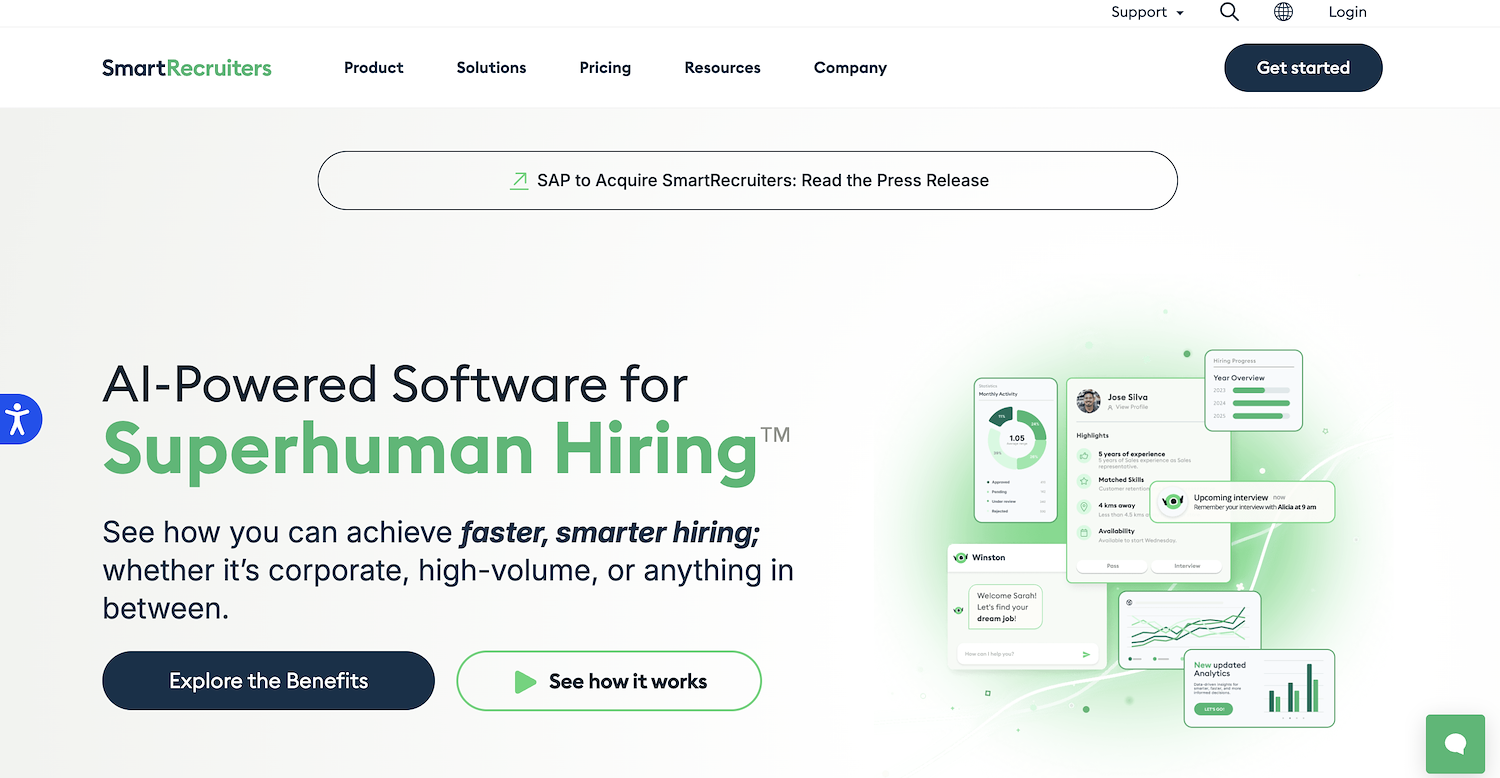
SmartRecruiters is a talent acquisition suite with an AI layer for automation. The platform handles the full recruitment cycle, from job posts to onboarding. It includes a recruitment CRM and is built for corporate employers with many open roles.
The system supports high-volume hiring in sectors like retail and healthcare. It is not designed for staffing agencies, a key difference from Bullhorn's focus.
SmartRecruiters's Main Features
- Offers a core platform, SmartOS, that covers the end-to-end recruiting workflow from job posting to onboarding.
- Includes the Winston Intelligence AI layer, which provides predictive insights, automation, and an AI-powered hiring agent.
- Features an AI talent matching engine and AI-powered candidate screening within its Select module.
- Provides a marketplace of plug-ins and can connect to major HCM suites or operate as a standalone system.
How SmartRecruiters Compares to Bullhorn
Average Review score: 4.3/5 stars based on 495 G2 reviews.
- SmartRecruiters integrates an AI layer for automation and predictive insights. This is a core part of its system, while Bullhorn often uses third-party tools for similar AI functions.
- The platform includes native onboarding features to manage the post-hire process. In contrast, Bullhorn typically relies on external integrations for comprehensive onboarding.
- Its interface is designed for ease of use in corporate environments, which can lead to faster team adoption. Bullhorn's interface is more complex, built for the specific needs of staffing agencies.
- The system supports high-volume corporate recruitment with features like AI-powered candidate screening. This focus differs from Bullhorn, which is built around the multi-client workflows of the staffing industry.
Where SmartRecruiters Falls Short Compared To Bullhorn
- SmartRecruiters offers fewer client management features. Bullhorn provides a unified system to track both candidate pipelines and client relationships, a core need for staffing firms.
- The platform's design suits corporate hiring, not agency recruitment. This means it might not support complex commission tracking or multi-client job orders as smoothly as Bullhorn does.
- It provides fewer options to customize workflows and data fields. In comparison, Bullhorn allows agencies to tailor the platform more closely to their specific business processes.
Cost Comparison
Neither Bullhorn nor SmartRecruiters provides public pricing information, as costs are customized for each organization. For the most accurate pricing details, we recommend visiting SmartRecruiters's official website to request a quote based on your company's needs.
4) iCIMS Talent Cloud
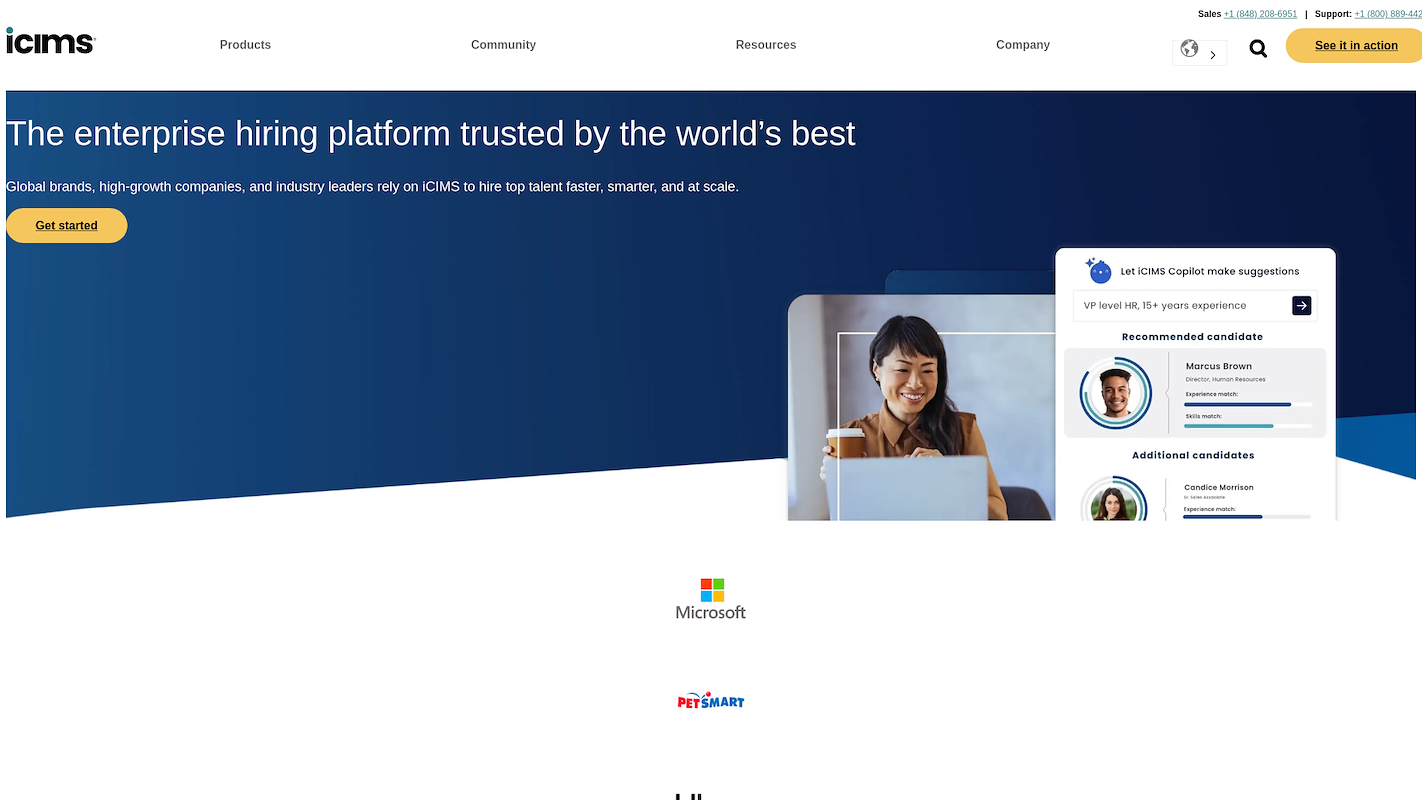
iCIMS Talent Cloud is a talent acquisition platform to attract, engage, hire, and advance talent. It provides tools for recruitment marketing, applicant track systems, and new hire processes. The system manages the entire talent lifecycle, from talent pool creation to internal mobility.
Its CRM capabilities support the engagement of passive candidates and relationship maintenance. The platform suits large enterprises with complex recruitment needs, particularly in healthcare, retail, and manufacturing.
iCIMS Talent Cloud's Main Features
- Offers an employer branding module with a career-site builder, a recruitment chatbot, and an employee-video testimonial studio.
- Provides industry-specific solutions with pre-configured workflows for sectors such as retail, healthcare, manufacturing, and finance.
- Includes an AI recruiting suite to personalize candidate experiences, find talent matches, and reduce time-to-fill.
- Features automated sourcing, nurture campaigns, and CRM capabilities for candidate relationship management through its Engage module.
How iCIMS Talent Cloud Compares to Bullhorn
Average Review score: 4.1/5 stars based on 777 G2 reviews.
- iCIMS provides an employer branding module with a career-site builder and video testimonial studio. This offers more tools to build a company's brand compared to Bullhorn's agency-focused feature set.
- The platform offers pre-configured workflows for specific corporate industries like healthcare and retail. This contrasts with Bullhorn's specialization, which centers on the staffing and recruitment agency model.
- Its native AI capabilities assist with tasks like candidate matching. Bullhorn, in comparison, often requires third-party integrations for similar AI functionalities.
- The system includes automated nurture campaigns to engage passive candidates. This provides a more structured approach to building talent pipelines than the standard CRM functions in Bullhorn.
Where iCIMS Falls Short Compared To Bullhorn
- iCIMS Talent Cloud focuses on candidate relationship management. Bullhorn, in contrast, provides a more integrated system to manage both candidate pipelines and client sales cycles, a core function for staffing agencies.
- The platform is designed for corporate hiring, not the specific needs of recruitment agencies. It may not support complex commission structures or multi-client job orders as smoothly as Bullhorn, which is built for that model.
- Some users report that its customization options can be limited for unique business processes. Bullhorn often provides greater flexibility for staffing agencies to tailor workflows and data fields to their specific operational model.
Cost Comparison
Neither Bullhorn nor iCIMS Talent Cloud provides public pricing information, as costs are customized for each organization. For the most accurate pricing details, we recommend visiting iCIMS Talent Cloud's official website to request a quote based on your company's needs.
5) JobDiva
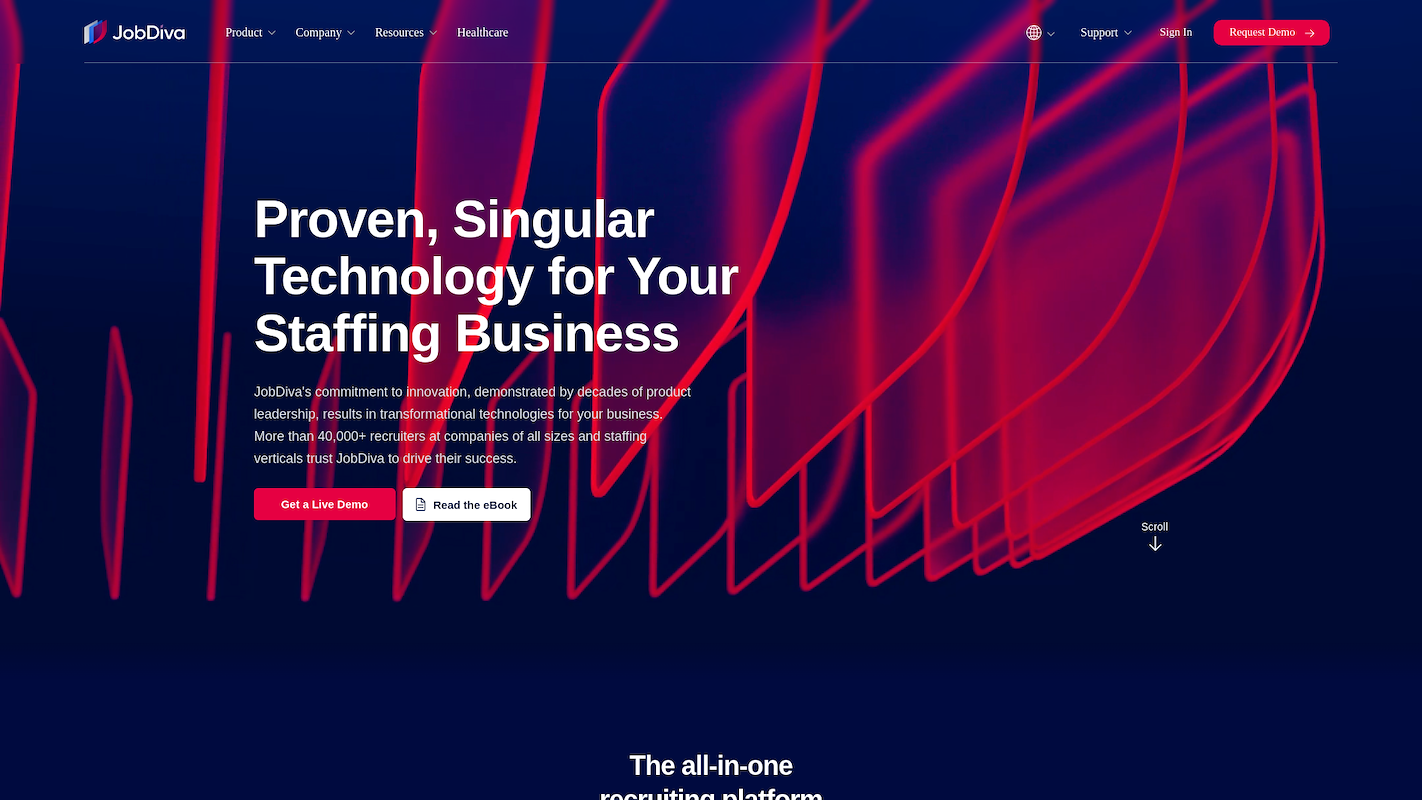
JobDiva is a platform for talent acquisition built for the staffing industry. It provides a unified system for applicant management, customer relationship management, and back-office tasks. The software serves recruitment agencies of all sizes, with tools to cover the complete hire cycle.
JobDiva's Main Features
- Includes a back-office suite, DivaFinancials, for invoicing, payroll, and margin calculations designed for staffing firms.
- Provides VMS synchronization to automatically pull requisitions and submit candidates to vendor management system portals.
- Offers mobile applications for recruiters, contractor time and expense entry, and a white-label applicant app for agencies.
- Holds multiple U.S. patents covering resume management, workflow automation, and margin calculation.
How JobDiva Compares to Bullhorn
Average Review score: 4.7/5 stars based on 1,559 G2 reviews.
- JobDiva includes a native back-office suite for invoicing and payroll. This provides a more integrated financial workflow compared to Bullhorn, which often requires third-party tools for these functions.
- The platform offers automatic VMS synchronization to pull job orders directly from client portals. This feature reduces manual data entry, a process that is less automated within Bullhorn's standard setup.
- Its patented resume parsing technology offers advanced candidate search capabilities. This can speed up sourcing when compared to the standard search functions available in Bullhorn.
- The system provides separate mobile apps for recruiters and contractors. This allows for easier time and expense tracking on the go, a feature that is less developed in Bullhorn's mobile offering.
Where JobDiva Falls Short Compared To Bullhorn
- Some users find the user interface less intuitive than more modern platforms. This can sometimes lead to a steeper learning curve for new recruiters compared to Bullhorn's configurable, though complex, layout.
- Its ecosystem of integrations is less extensive than Bullhorn's marketplace. Agencies that rely on many niche third-party tools may find more pre-built connections available for Bullhorn.
- The platform's CRM is comprehensive, but Bullhorn's is often more focused on the sales and business development cycle. This makes Bullhorn a strong choice for agencies that prioritize client acquisition tracking.
Cost Comparison
While we've covered key features and use cases in this comparison, pricing models can vary significantly between tools. For the most accurate and up-to-date pricing information, we recommend visiting JobDiva's official website.
Expand Sales Outreach with 11x
For teams focused on sales development, 11x presents a different path. Its digital workers handle outreach and lead qualification, which frees your team to close deals. If the priority is to scale sales activity without a larger headcount, you can explore how this model fits your business.
With 11x, AI agents run the sales playbook. Alice finds accounts, enriches data, and handles outreach, while Julian qualifies leads and books meetings. This approach consolidates tools for data, outreach, and email warmup into a single platform, removing the need for extra software or hires.
Book a demo to see it in action.
6) JazzHR

JazzHR is a recruitment software for small and medium-sized businesses. It provides tools to post jobs, source candidates, and manage applicant pipelines and communication. The platform helps companies formalize their recruitment process and is an option for businesses that need an affordable, easy-to-use solution.
JazzHR's Main Features
- Posts jobs to multiple sites with a single click.
- Manages the creation of offer letters and captures e-signatures.
- Includes tools for compliance and reporting on hiring metrics.
- Offers employer-branding and white-label options for a customized career page.
How JazzHR Compares to Bullhorn
Average Review score: 4.4/5 stars based on 796 G2 reviews.
- JazzHR offers an intuitive interface that many users find easy to learn. This contrasts with Bullhorn, which often has a steeper learning curve due to its complex feature set for staffing agencies.
- The platform posts jobs to multiple free job boards with a single click. This provides a more direct and cost-effective sourcing method compared to Bullhorn's standard job distribution tools.
- It provides transparent, tiered pricing plans designed for small and medium-sized businesses. This is different from Bullhorn, which uses custom quotes tailored to larger organizations.
- The tool manages the creation of offer letters and captures e-signatures natively. This function in Bullhorn often relies on third-party integrations from its marketplace.
Where JazzHR Falls Short Compared To Bullhorn
- JazzHR focuses on the hiring process and lacks the deep CRM functionality of Bullhorn. Staffing agencies that need to track client interactions and sales pipelines in one system may find Bullhorn's integrated approach more suitable.
- The platform is not designed for the staffing industry's specific needs. It may not support complex commission calculations or temporary staffing workflows, which are standard features within Bullhorn for managing agency financials.
- Its integration options are more limited compared to Bullhorn's extensive marketplace. Agencies that rely on specialized third-party tools for tasks like background checks or payroll may find fewer pre-built connectors available.
Cost Comparison
JazzHR provides transparent, tiered pricing at $79, $269, and $420 per month. This contrasts with Bullhorn's custom quote model, making JazzHR a more predictable option for SMBs. For detailed information, we recommend visiting JazzHR's official website.
7) Workday Recruiting
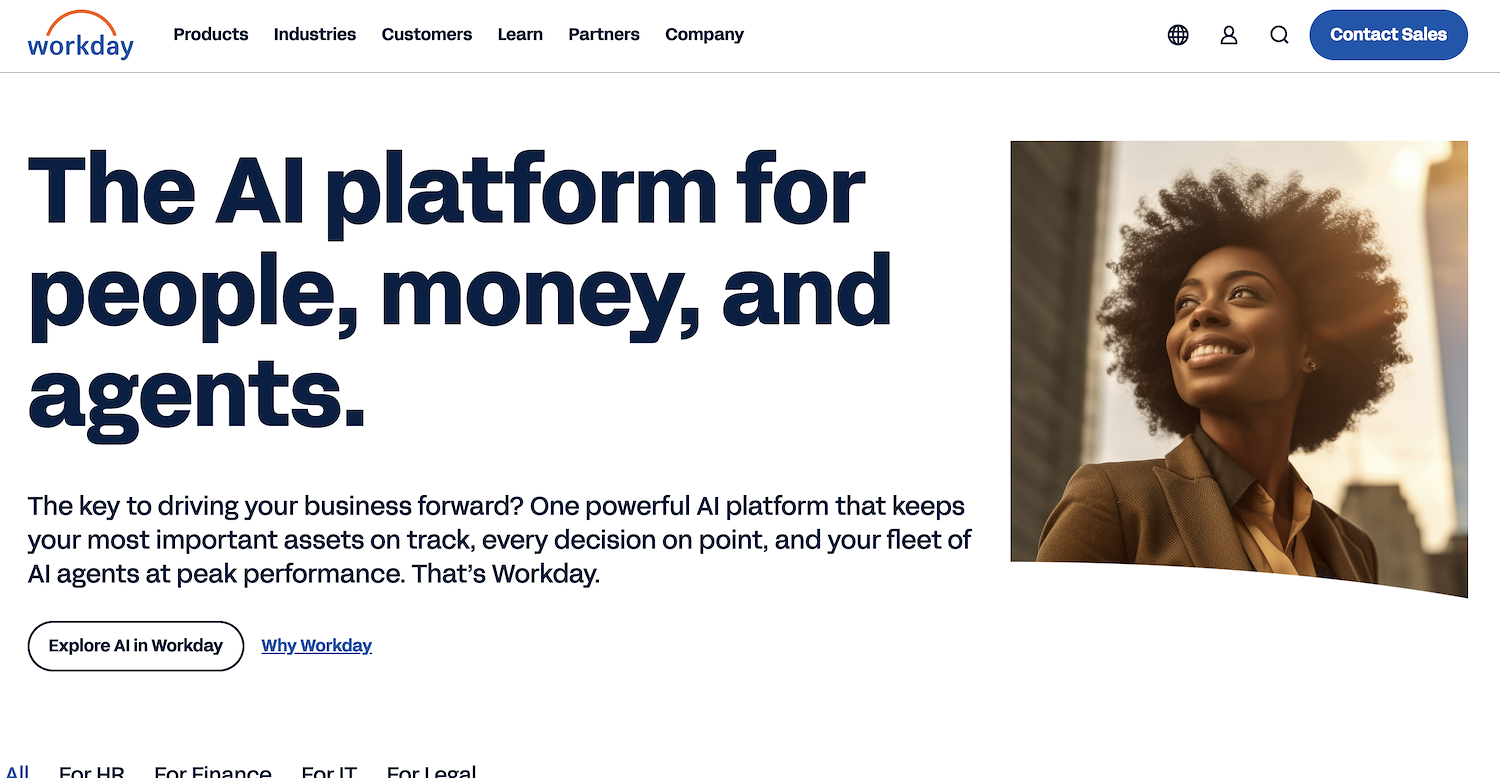
Workday Recruiting is an application within the Workday platform for human capital management. It provides a system for the talent acquisition process, from candidate search to the hire. The tool connects recruitment with HR functions inside one ecosystem.
For candidate relationship management, it allows teams to create talent pools and maintain contact with prospects. This design supports companies that want a unified approach to HR and recruitment data.
Workday Recruiting's Main Features
- Connects recruitment with core HR functions for a unified approach to talent and financial data.
- Provides end-to-end management of the talent acquisition process, from sourcing to onboarding.
- Includes candidate relationship management tools to build and engage with talent pools.
- Offers analytics that combine recruiting metrics with broader human capital management data.
How Workday Recruiting Compares to Bullhorn
Average Review score: 3.7/5 stars based on 95 G2 reviews.
- Workday Recruiting connects recruitment with core HR and financial data within a single system. This provides a unified view of talent and business metrics, unlike Bullhorn, which focuses primarily on the recruitment and sales cycle.
- The platform offers stronger tools for internal mobility and talent advancement. It manages an employee's entire lifecycle, whereas Bullhorn's scope is centered on the external recruitment process for staffing agencies.
- Its analytics combine recruiting metrics with broader human capital data from the same platform. This allows for more comprehensive insights into talent management compared to Bullhorn's reporting, which is specific to recruitment and sales.
- This tool includes native onboarding features that are part of the unified employee journey. In comparison, Bullhorn typically relies on integrations from its marketplace to manage the post-hire process.
Where Workday Recruiting Falls Short
- Workday Recruiting lacks the integrated sales CRM that Bullhorn provides. This makes tracking client relationships and business development difficult for staffing agencies that need both functions in one system.
- The system is not designed for the financial complexities of the staffing industry. It does not offer native support for commission tracking or temporary staffing payroll, which are core features in Bullhorn.
- Some users report that its workflows can be rigid. Customizing the hiring funnel or adding simple candidate tags can be a challenge, whereas Bullhorn generally allows more tailoring for specific agency processes.
- Its focus is on corporate HR processes, not high-volume agency recruitment. This can result in a slower user experience for recruiters who need to quickly manage candidates across multiple clients.
Cost Comparison
Neither Bullhorn nor Workday Recruiting provides public pricing information, as costs are customized for each organization. For the most accurate pricing details, we recommend visiting Workday Recruiting's official website to request a quote.
8) SAP SuccessFactors Recruiting

SAP SuccessFactors Recruiting is a component of the SAP SuccessFactors Human Experience Management (HXM) Suite. It offers tools for the recruitment process, from sourcing to hire. The platform connects talent acquisition with other HR functions inside the SAP ecosystem.
The system includes candidate relationship management for the creation and maintenance of talent pipelines. This design serves large organizations that require an integrated approach to human resources and recruitment.
SAP SuccessFactors Recruiting's Main Features
- Connects recruiting with core HR functions, providing a unified source of people and skills data.
- Offers support for over 100 localizations with built-in legal and regulatory updates for different regions.
- Includes native onboarding tools to manage the transition from candidate to new hire within the same system.
- Provides tools for job posting and applicant tracking as part of its end-to-end recruiting platform.
How SAP SuccessFactors Compares To Bullhorn
Average Review score: 3.9/5 stars based on 682 G2 reviews.
- SAP SuccessFactors connects recruitment with core HR functions like payroll and performance management. This provides a unified view of employee data, while Bullhorn focuses on recruitment and sales.
- The platform supports over 100 localizations with built-in legal and regulatory updates. This offers more extensive global compliance compared to Bullhorn's standard setup.
- It includes native onboarding tools to manage the new hire journey inside the same system. Bullhorn, in comparison, often uses third-party integrations for these functions.
- This tool has stronger features for internal talent mobility and employee development. Bullhorn's scope centers on external hiring for staffing agencies.
Where SAP SuccessFactors Falls Short
- SAP SuccessFactors Recruiting lacks an integrated sales CRM. This can be a challenge for staffing agencies that need to manage client relationships and sales pipelines within the same system, a function central to Bullhorn.
- The tool is not built for the financial complexities of the staffing industry. It lacks native support for commission calculations or temporary staffing payroll, features that are standard in Bullhorn for managing agency-specific financials.
- Some users report that its workflows can be rigid. This might make it less suitable for staffing agencies with unique processes, as Bullhorn generally offers more flexibility to tailor the platform to specific business models.
Cost Comparison
Neither Bullhorn nor SAP SuccessFactors Recruiting provides public pricing information, as costs are customized for each organization. For the most accurate pricing details, we recommend visiting SAP SuccessFactors Recruiting's official website to request a quote.
9) Zoho Recruit
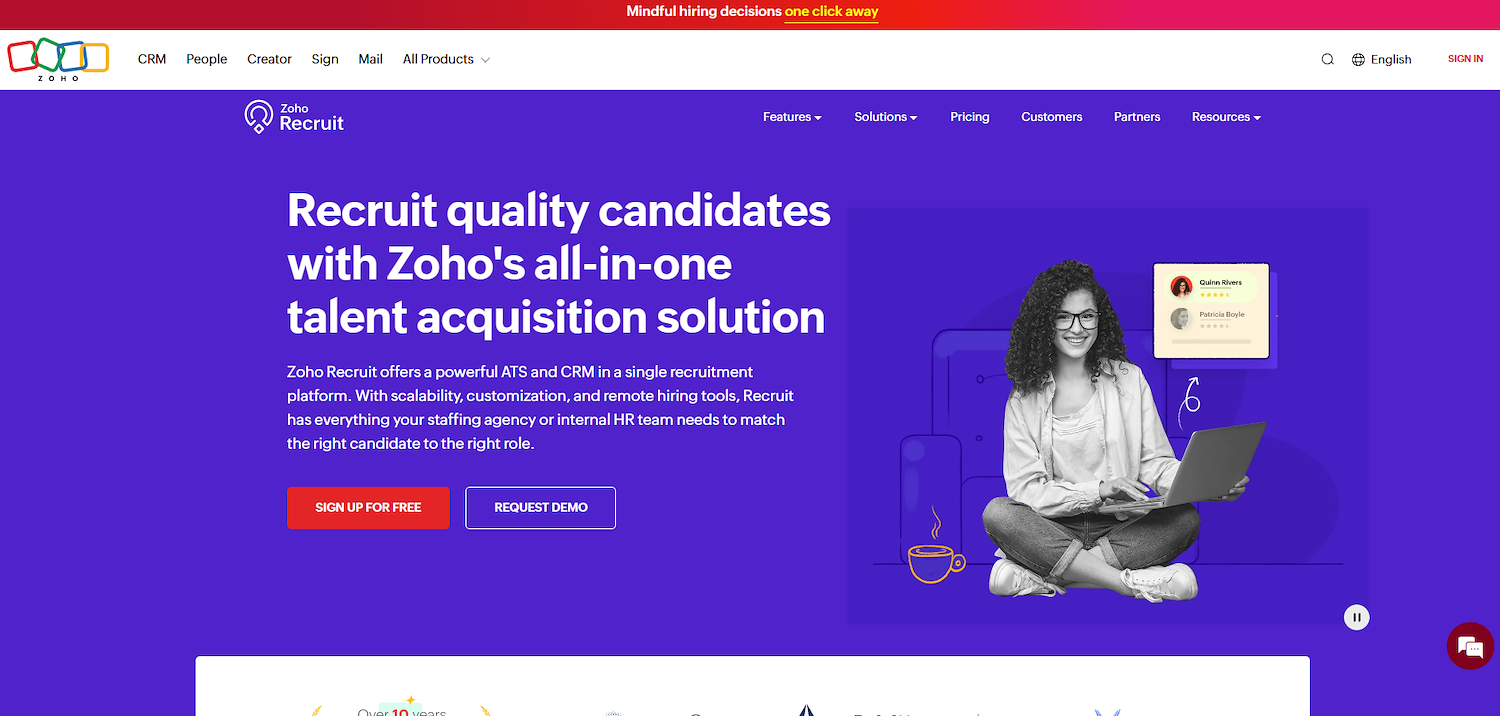
Zoho Recruit is a talent acquisition platform that serves both staffing agencies and corporate HR departments. It combines applicant tracking with customer relationship management tools. The system helps manage candidate, client, and contact information in one interface. As part of the Zoho ecosystem, it connects with other business applications for a more unified workflow.
Zoho Recruit's Main Features
- Offers workflow automation for tasks like sending emails and updating interview statuses.
- Provides user, role, and access management to control platform permissions.
- Includes tools for sourcing candidates, identifying prospects, and posting to job boards.
- Features dashboards with reports and analytics to inform hiring strategies.
How Zoho Recruit Compares To Bullhorn
Average Review score: 4.4/5 stars based on 1,793 G2 reviews.
- Zoho Recruit provides public, tiered pricing plans, including a free version for one recruiter. This contrasts with Bullhorn's model, which relies on custom quotes tailored to each organization.
- The tool connects natively with the broader Zoho ecosystem of business applications. This offers a more unified workflow compared to Bullhorn, which typically uses its marketplace for third-party integrations.
- Its workflow automation handles routine tasks, such as sending emails and updating interview statuses. This provides a different approach to efficiency compared to Bullhorn's focus on tailoring platform layout and data fields.
- The platform serves both staffing agencies and internal corporate HR teams. This dual focus offers a different kind of flexibility compared to Bullhorn, which is built specifically for the recruitment agency model.
Where Zoho Recruit Falls Short Compared To Bullhorn
- Zoho Recruit serves both corporate HR and staffing agencies. This dual focus means it may lack some specialized features for temporary staffing or complex commission tracking that are standard in Bullhorn.
- The platform's CRM is less focused on the sales and business development cycle common in staffing. In comparison, Bullhorn integrates these sales activities more deeply, which helps agencies that prioritize new client acquisition.
- Some users find its integration capabilities outside the Zoho ecosystem are less extensive than Bullhorn's marketplace. Agencies that depend on many specific third-party tools might find more pre-built connectors available for Bullhorn.
Cost Comparison
Zoho Recruit offers transparent pricing with a free plan and paid tiers at $30, $60, and $90 per recruiter monthly. This contrasts with Bullhorn's custom quote model, making Zoho a more predictable option for businesses managing a budget. For full details, visit Zoho Recruit's official website.
10) ClearCompany
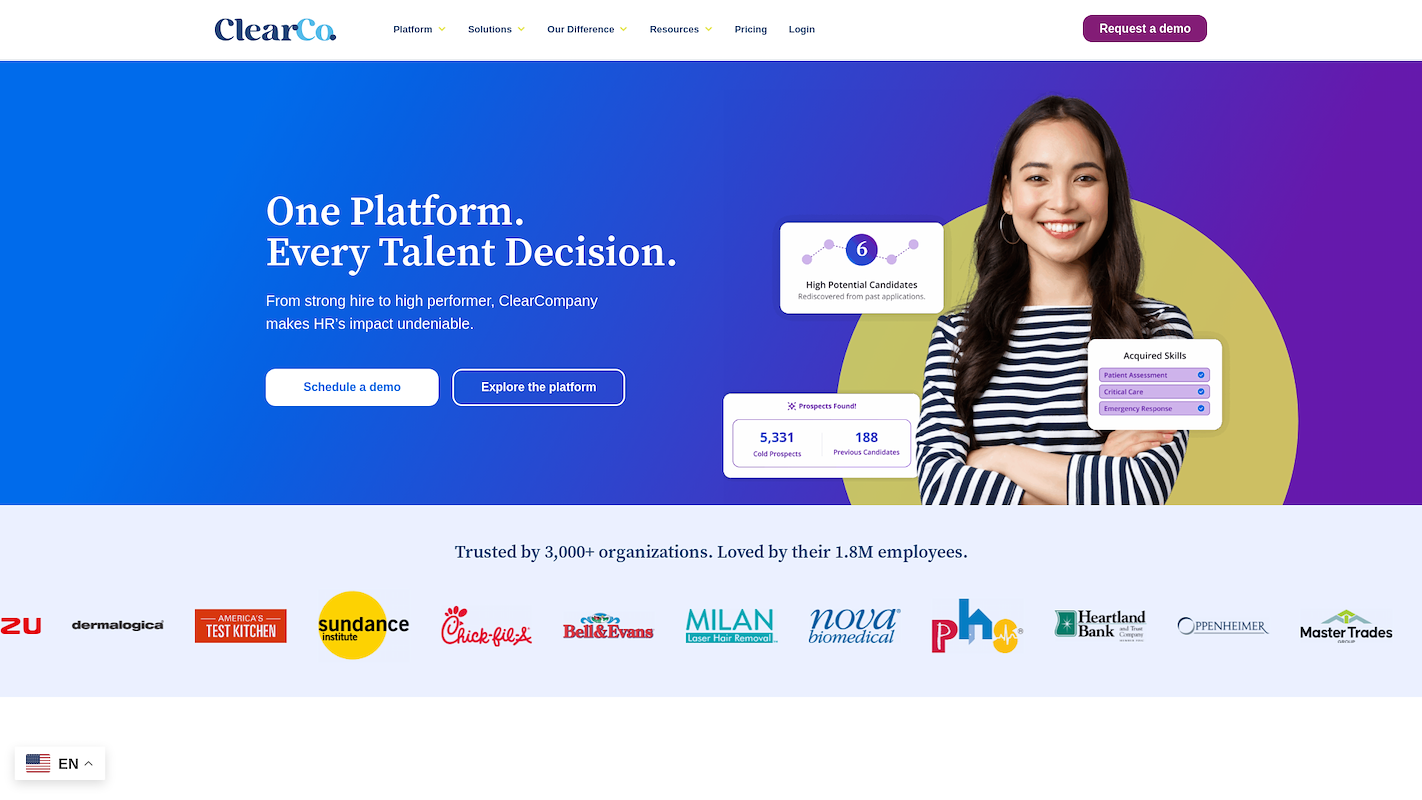
ClearCompany provides a talent management platform. It connects recruitment with performance management and employee engagement tools. The system creates a single source for the entire employee lifecycle.
It is for businesses that want to link their talent strategy to company objectives. The platform offers a way to manage each stage from hire to retirement and maintain candidate relationships.
ClearCompany's Main Features
- Combines applicant tracking, onboarding, performance management, and employee engagement tools.
- Offers a virtual onboarding solution to help new hires acclimate to their roles.
- Includes performance and learning management systems for setting goals and providing feedback.
- Provides people analytics to inform strategic decisions using HR data.
How ClearCompany Compares To Bullhorn
Average Review score: 4.6/5 stars based on 472 G2 reviews.
- ClearCompany connects recruitment with performance management and employee engagement in one system. This provides a view of the entire employee lifecycle, while Bullhorn centers on the recruitment and sales process for staffing agencies.
- The platform includes native tools for onboarding new hires. In comparison, Bullhorn typically requires integrations from its marketplace to manage the post-hire process.
- It provides performance management systems to set goals and track employee development. This is a feature not native to Bullhorn, which is designed for external hiring.
- This tool offers people analytics that connect hiring data with employee performance. This allows for more comprehensive HR insights than Bullhorn's reports, which focus on recruitment and sales metrics.
Where ClearCompany Falls Short Compared To Bullhorn
- ClearCompany lacks the integrated sales CRM that is central to Bullhorn. This makes tracking client relationships and business development difficult for staffing agencies that need both functions in one system.
- The platform is not designed for the financial complexities of the staffing industry. It does not offer native support for commission tracking or temporary staffing payroll, which are core features in Bullhorn.
- Some users report that its workflows can be rigid for agency-specific needs. In comparison, Bullhorn generally allows more tailoring of the system to match the fast-paced processes of recruitment firms.
Cost Comparison
Neither Bullhorn nor ClearCompany provides public pricing information, as costs are customized for each organization. For the most accurate pricing details, we recommend visiting ClearCompany's official website to request a quote.
Which One Should You Go With?
Choosing a Bullhorn alternative depends on many factors specific to your business. This guide reviewed several options to help you create a shortlist for further evaluation.
If your focus is on expanding sales outreach, 11x offers a different approach. Its digital workers handle prospecting and lead qualification, allowing your team to focus on closing deals. This can help scale sales activity without increasing headcount.




